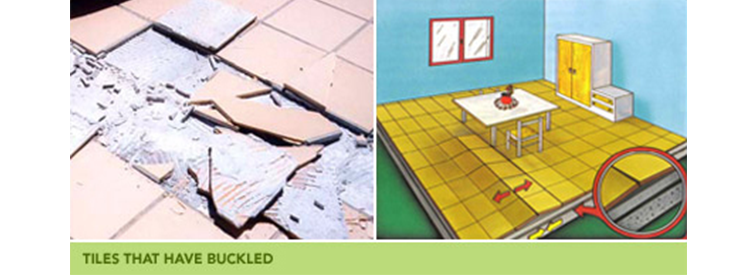
Structural movement in homes and buildings is a fact of life. Different substrates will move, settle, shrink, or expand depending on the conditions. Some tiles can also grow in size as they absorb moisture in the period shortly after manufacture.
Problems can develop if tiles are laid without flexible adhesives, and no allowance for the expansion and contraction of the substrate.
One situation that can develop is if tiles are laid onto concrete before it has had time to completely cure. The general rule of thumb is to allow one month to cure per 25mm of thickness of the concrete slab. Even then, the average house slab can take up to two years to completely cure (and shrink). If this movement is not allowed for by using the correct adhesives and including expansion joints, something has to give. There have even been reports of tiles exploding unexpectedly. This is due to extreme lateral pressures as the walls and floor move in different directions. Nobody is expecting their tiles to explode!
What can cause the problem?
• Not using the corrective adhesive over a concrete slab that is still curing (we refer to such a slab as being green). Ranjanas Ceramic Tiles will advise on the correct product to use.
• Not allowing for expansion or movement around the perimeter of a tiled area, and at 4.5 metre intervals in a grid pattern through the floor.
• Incorrect installation of movement joints. These must travel through the tile and adhesive to the substrate and must by fully filled with a flexible silicone or rubber compound.
So what can I do now?
Incorrectly laid tiles are solely the responsibility of the tiler or builder. You will need to arrange for the tiler or builder to fix the problem.
In the unlikely situation that the problem is discovered early, and a flexible adhesive was used, and some tiles have not actually exploded, one solution can be to cut expansion joints around the perimeter. This is done by cutting 6mm off the edge of the tiles (through both the tile and the adhesive bed) and removing that strip. Then fill it with silicone. This is not a guaranteed solution, so it may still be worth talking to your tiler or builder.
Otherwise, the only remedy is to remove the tiles and retile the area correctly. The movement that would cause buckling prevents replacement of the buckled area, because the removed tiles will not fit into the smaller space.